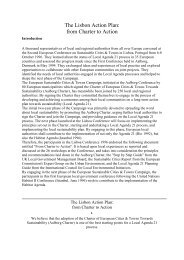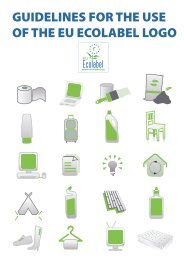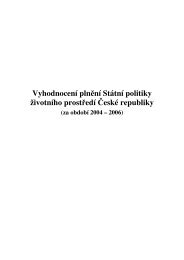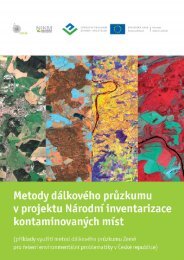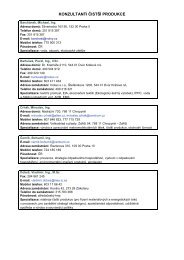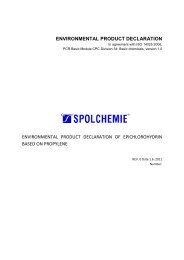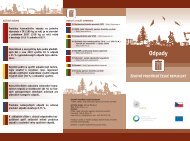Environmental Technologies and Eco-innovation in the Czech ...
Environmental Technologies and Eco-innovation in the Czech ...
Environmental Technologies and Eco-innovation in the Czech ...
You also want an ePaper? Increase the reach of your titles
YUMPU automatically turns print PDFs into web optimized ePapers that Google loves.
decompose <strong>the</strong> mentioned specific substances, are be<strong>in</strong>g carried out <strong>in</strong> <strong>the</strong> <strong>Czech</strong><br />
Republic. The ma<strong>in</strong> obstacle for <strong>the</strong>ir successful application <strong>in</strong> normal operation are<br />
completely different cultivation conditions, where, contrary to <strong>the</strong> activated sludge<br />
microorganisms, <strong>the</strong>y work at pH levels lower than 5 <strong>and</strong> <strong>the</strong> temperatures higher than<br />
26 °C. Activated sludge microorganisms work at pH levels of 6–7.<br />
Municipal waste water ma<strong>in</strong>ly conta<strong>in</strong>s organic substances <strong>and</strong> compounds<br />
of nitrogen <strong>and</strong> phosphorus. Higher nitrogen <strong>and</strong> phosphorus concentrations <strong>in</strong><br />
water leads to <strong>the</strong> eutrophication 12 of water with all accompany<strong>in</strong>g negative effects<br />
(<strong>in</strong>creased costs for treat<strong>in</strong>g this surface water <strong>in</strong>to dr<strong>in</strong>k<strong>in</strong>g water, hygienic problems<br />
for bath<strong>in</strong>g, <strong>and</strong> fluctuations <strong>in</strong> <strong>the</strong> concentration of oxygen dissolved <strong>in</strong> <strong>the</strong> water,<br />
etc.). Also for this reason, <strong>the</strong> limits of total nitrogen <strong>and</strong> phosphorus at <strong>the</strong> discharge<br />
po<strong>in</strong>t from waste water treatment plants are constantly be<strong>in</strong>g reduced. Therefore, it<br />
was necessary to adapt WWTP technologies for nitrogen <strong>and</strong> phosphorus removal (<strong>the</strong><br />
orig<strong>in</strong>al biological treatment was designed ma<strong>in</strong>ly for organic substance removal).<br />
It has been determ<strong>in</strong>ed that <strong>the</strong> most important factor for <strong>the</strong> eutrophication<br />
of water is phosphorus concentration. Dur<strong>in</strong>g biological treatment, its removal<br />
with excessive sludge occurs because it is possible to select processes that force<br />
microorganisms to accumulate more phosphorus <strong>in</strong> <strong>the</strong>ir bodies. Based on today’s<br />
legislative requirements on <strong>the</strong> discharge from WWTPs, this biological phosphorus<br />
removal is <strong>in</strong>sufficient <strong>and</strong> not too efficient. Today, phosphorus removal from waste<br />
water occurs through chemical precipitation, namely by dos<strong>in</strong>g iron <strong>and</strong> alum<strong>in</strong>ium<br />
salts <strong>in</strong>to <strong>the</strong> sludge <strong>and</strong> waste water mixture <strong>in</strong> <strong>the</strong> activation tank.<br />
On <strong>the</strong> contrary, nitrogen removal occurs through new biological treatment<br />
methods, where <strong>the</strong> legal limits are achieved by correct sequenc<strong>in</strong>g of <strong>the</strong> parts<br />
of a WWTP l<strong>in</strong>e with different concentrations of oxygen dissolved <strong>in</strong> water. The<br />
way of sequenc<strong>in</strong>g oxic (with oxygen present) <strong>and</strong> anoxic zones (with lower oxygen<br />
concentrations) <strong>in</strong> a technological l<strong>in</strong>e may be generally described as follows:<br />
<strong>the</strong> waste water be<strong>in</strong>g brought <strong>in</strong> enters <strong>the</strong> anoxic zone, <strong>in</strong>to which <strong>the</strong> thickened<br />
activated sludge is lead <strong>and</strong> <strong>the</strong> activation mixture from <strong>the</strong> end of <strong>the</strong> oxic zone with<br />
high nitrate concentrations. In <strong>the</strong> anoxic zone, <strong>the</strong> development of denitrification<br />
bacteria occurs that reduce <strong>the</strong> nitric nitrogen to nitrogen gas, <strong>and</strong> for this process<br />
<strong>the</strong>y use <strong>the</strong> organic substances from <strong>the</strong> waste water be<strong>in</strong>g brought <strong>in</strong>. The activation<br />
mixture flows off <strong>in</strong>to <strong>the</strong> oxic zone where <strong>the</strong> rema<strong>in</strong><strong>in</strong>g organic pollution is removed<br />
<strong>and</strong> <strong>the</strong> ammonia nitrogen is oxidised <strong>in</strong>to nitrates.<br />
12 eutrophication – excessive growth of algae <strong>and</strong> cyanobacteria, <strong>the</strong> cause of which is a high concentration of nutrients <strong>in</strong><br />
water; this ma<strong>in</strong>ly <strong>in</strong>cludes nitrogen <strong>and</strong> phosphorus compounds<br />
82 | 83




